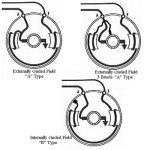Wow! I didn't realize trying to help out would bring about such an attack. As I stated, it's a quick test to see if the generator works. It's not meant to be a "bench test". That can happen later if it's determined the generator is the problem. You're going way overboard for a field test and pulling the belt is not necessary for a quick and dirty evaluation.
And unless you know some secret magic about the Lucas generator, YOU are all wrong when you state to jump the BAT (AKA: Armature) post and Field post. It's not necessary as the two are connected internally via the field coils. The Armature post is the OUTPUT of the generator.
All the best and tractor on.
Ken
Pulling the belt is 100% necescarry for a motor test.. otherwise you can't tell if the genny is spinning with a belt holding it in place!

BAT is not ARM.. BAT is the hot battery side connection on the regualtor which is seperated from the ARM via cutout.
When i specifically state to jump BAT to FIELD, for instance.. for polarization.. I AM doing so because you need current to flow to create some residual magnetics in the pole pieces.. Can't do that by jumpering ARM to FLD with the tractor off. ( no power is being generated, thus cutout is open.. ).. Aslo.. in a motor test, the tractor will be off.. thus no power is being made.. thus the cutout is open.. thus to motor the genny, you have to provide BATTERY to the armature,.. IE.. bypassing the cutout, and you have to bias the field.. again.. going this with BATTERY.
No attack.. my message stated what it did for a reason.. To declare a genny bad without fully testing it is a waste of time and money...
I'm not going to argue with you.. but I can read it ( diagnostic procedures for that genny ) to you right out of the book.
On a b-circuit genny.. one side of the field is touching case ground.. the other side terminates at the field spade connector on the back of the genny.
Armature is the charge stud ( who indicated otherwise? )
On an A-Circuit genny, one sid eof the field coil contacts the armature... the other terminates at the fild post.
I can post a pictoral diagram to explain the differences in A-Circuit and B-circuit genrerators, that show the field connections very clearly...
in fact.. here it is.. look at the lower of the 3 pictures.. it is a B circuit genny like a lucas... it should make sense to you now.
The last paragraph of your message describes an A-Circuit generator pretty good.... only problem is we are talking about a B circuit genny.
Ford used 2-brush A-Circuit generators up thru the end of the 8N run. ( 9n/2n were 3 brush gennies.. and some early 8n gennies were a bit weird too.. ) In any case.. with the introductuion of the NAA in late 52 for the 53 year, ford went to a B circuit genny... When ford dumped the 4 cyl tractors in 65, they went to the lucas B circuit gennies.. For practical electrical generation.. the B circuit gennies on the frods from 53-64 worked the same as the 65+ lucas gennies.. There were obvious cosmetic and manufacturing differences int he ford and lucas gennies, and different specs for current limitation.. etc.. but in generall.. all B circuits work alike..and All A circuits work alike.
A-circuit use a field that is internally connected to the armature on one side.. and a filed post on the other.. field current is provided when the vibrating contact in the regulator grounds the field coil. There will also be a bias resistor in the regulator from the field contact to ground.. as the genny spins up, the residual magnetic field in the pole pieces starts low voltage generation in the armature.. which directly starts feeding the field.. this 'bootstraps' power generation up untill the cutout closes and the battery starts to charge.. with the armature providing power, and the regulator ground.. this is all A-circuit.. refer to the top left pic in the attachment.
Soundguy
